
copyright Jonah Ohayv, Feb. 2004
Click on photos for enlargement.



When I reached Wiltshire however, the formation was harvested. An American croppie, "Freeland", convinced me that it was still worth a visit and once there, assisted me. And here I discovered again, that evidence you would never see in the standing crop-circle becomes clear after harvest!
The next photos are from junctions in the formation where two of the smaller "rings" and a "cross-bar" (hexagon side) meet. This pattern was in all 12 similar junctions throughout the crop-circle.
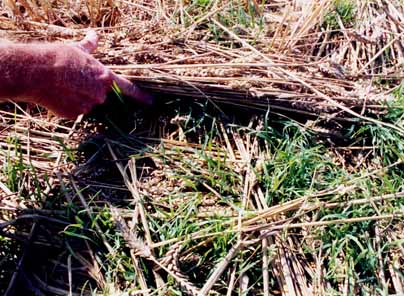
4-layered weaving:
Half the horizontal sheath (which I've lifted) lies on top of straws from the right and left sides of the vertical lay - which lie on top of the other half of the horizontal sheath - which (as I point out) lies on top of the rest of the vertical lay.
The one vertical sheath (clear at the photo's right) continues to the right into one ring and the other vertical sheath continues to the left into another ring, while the horizontal sheath is part of a cross-bar over and under them.
The following photos are examples of the clearest cases I've seen of weaving in the 72 formations I've visited.
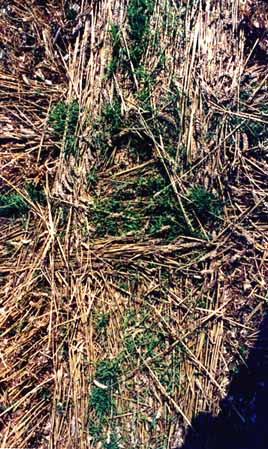
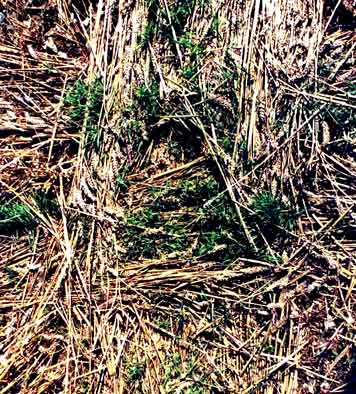
From the photo's top working down - First the vertical sheath (part of a cross-bar) is divided into three sections (left, middle, and right) upon "entry" into the junction. The left and right sections overlap the first horizontal sheath (part of a small ring in the formation, crossing the photos from their upper middle left to upper middle right) - yet most of the vertical middle section lies under that sheath.
A second horizontal sheath (part of the next adjacent small ring, crossing the photos from lower middle left to lower middle right) lies under the vertical sheath's left section - yet on top of that sheath's middle section and also partially its right section.
And in betweeen the two horizontal sheaths (from the photo's middle left and diagonally up rightwards), you can see part of one of the larger formation rings, which here lies over the lower horizontal ring, under the vertical cross-bar's left section, over its middle section, and under its right section.
Part of the of the vertical sheath's right section lies atop all this, and part continues under all this.
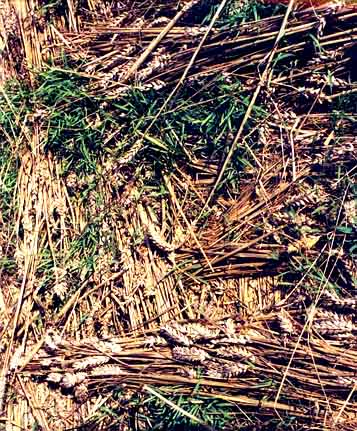
The horizontal sheath (comparable to the crossbar's "entry" position described above) divides into 3 sections, where its (in the photo) highest and lowest sections are atop everything else. But the main middle section of the horizontal sheath is again over the right vertical sheath (part of a ring), but under the left vertical sheath (part of another ring).
The point is, that nobody's going to divide all these sheaths by hand and weave them at zero-ground level so intricately, in their distant but similar positions in the formation. And each cross-bar must be downed in two stages, since part goes under rings and part over. I don't think this is feasible to do even in daylight, let alone at night!
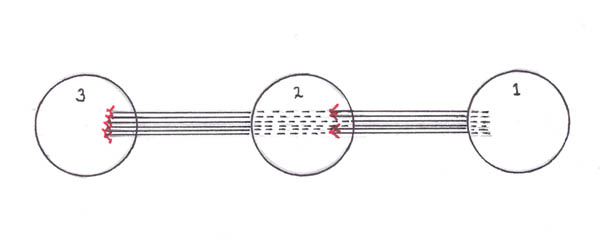
Examining the cross-bars' lay through their groups of 3 smaller circles, we found the same construction sequence in each case. The whole bar-line starts just under the edge of circle 1. Its main section continues underneath and through circle 2, but by contrast, the bar's outermost right and left sections lie on top of circle 2 at first. The rejoined whole bar ends atop circle 3's entrance. As with the ring junctures, each cross-bar was therefore made both partly beforehand and partly afterwards, at its middle circle.
As shown below, in the one checked case of the diameter's lay between the circles along it, its outermost right and left sections again overlay the entrances to three of the four circle areas on its route (the fourth example was unclear), although its innermost main section lay under them - proving that the diameter was also made in two go's, both before and after its circles.
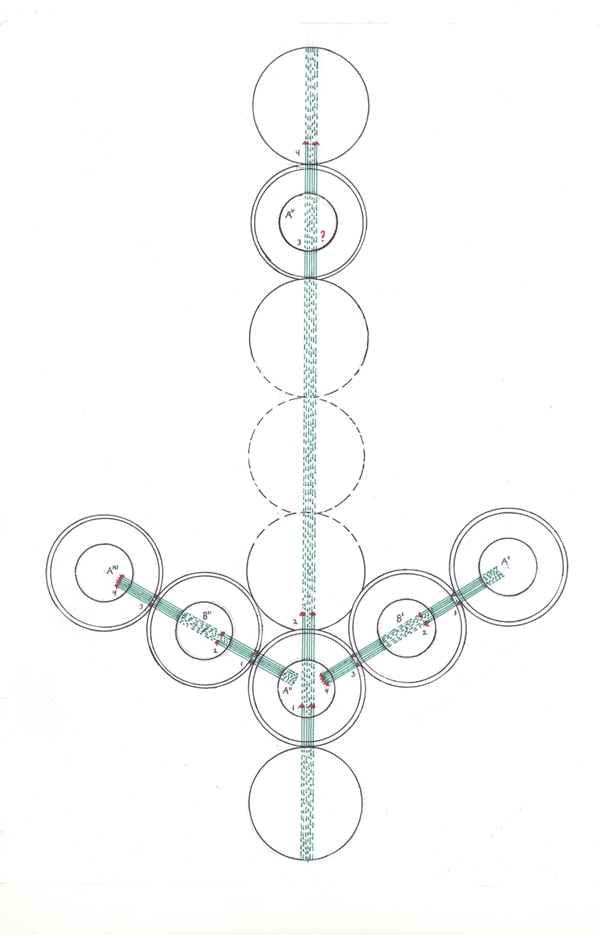 click
click
The lower half of the diagram above also reveals this necessary construction order of each of the crop-circle hexagon's sides:
1.) The whole cross-bar starts under circle A's coming position.
2.) All rings start clockwise and proceed through their left side.
3.) The whole bar then crosses circle A's ring.
4.) The central part of the bar then continues up to the edge of circle A''s position.
5.) All circles are then downed and all rings proceed through their own right side (in no revealed time-order).
6.) The outermost sections of the bar then cross circle B's ring at its right side, next overlay circle B's entrance, and next cross circle A''s ring at its right side.
7.) The whole bar ends across circle A''s entrance.
This combination is not just some straight-forward ploughing down in simple steps, but requires a consistent, detailed, finely-timed execution.
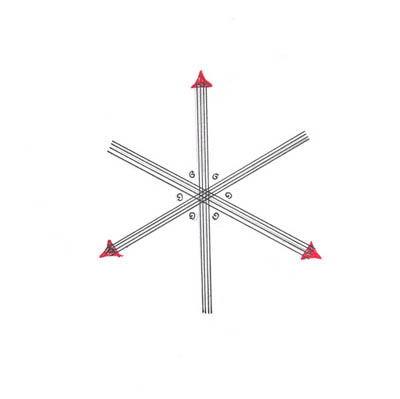
Each pair of adjacent diameters crossing the formation runs in opposite directions, tying their 3-way pattern neatly together.
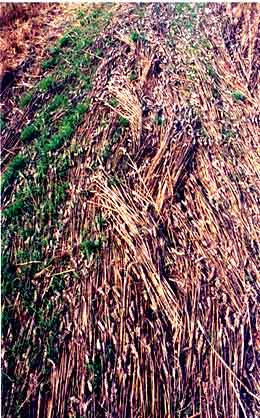
Another sort of strange but clear overlapping runs through the formation's surrounding rim. The rim's entire lay points forwards (clockwise), yet an only inches thick section of its central strip progressively overlaps backwards (counter-clockwise). This section's sheaths were laid after the broad areas to their right and left. Someone would have to lay very nearly all the rim's crop walking forwards, and then walk backwards for at least 375 feet (if the tramlines are say 60 feet apart) around the whole rim bending also these central sheaths forwards in alternating directions.
Not impossible certainly, just unlikely.
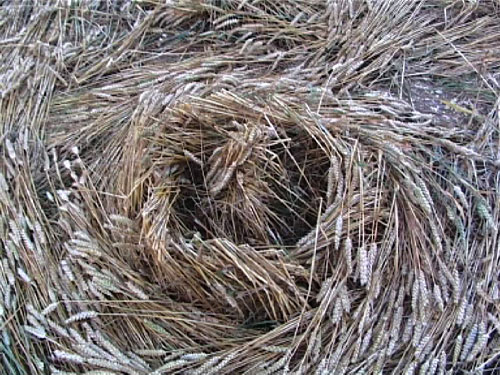
All these varying sorts of weaving - both invisible from the air and, I think, too impractical for hoaxing - have a purpose:
They're an impressive way to tie all the formation's sections together nicely, making a total organic symbol with a strongly integrated base.
I recommend revisiting interesting formations just after harvest!